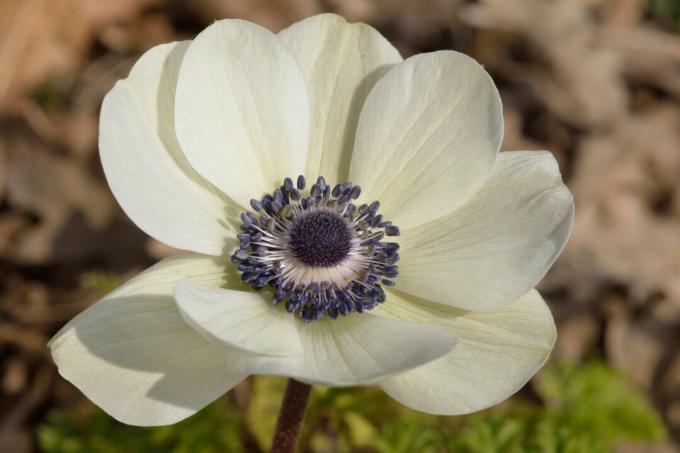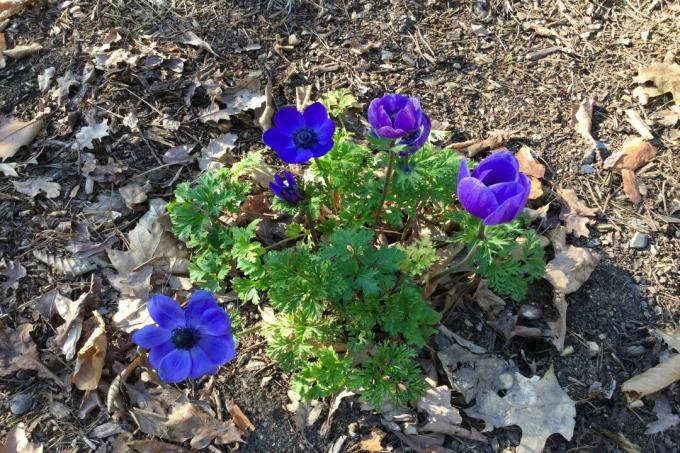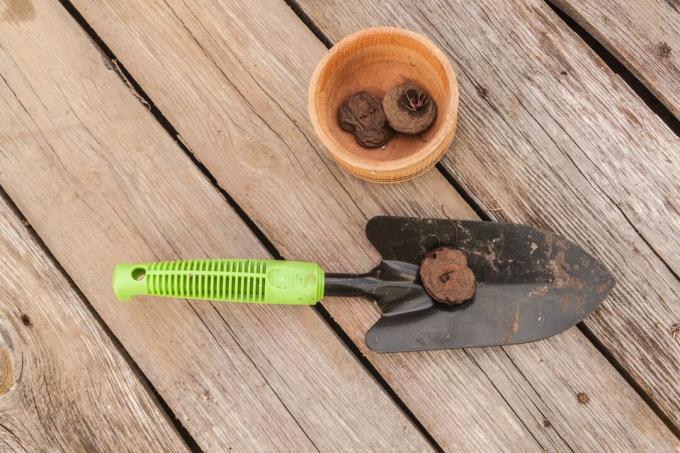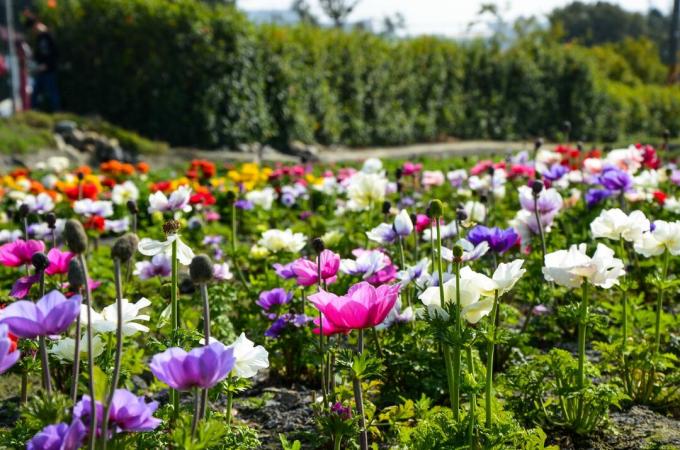Crown anemones enchant with their delicate, colorful flowers - whether in the bed or in the flower pot. In addition, this flowering perennial is suitable for gardening beginners, because it is quite easy to care for.

The crown anemone (Anemone coronaria) is unfortunately often only used once a year. In mild locations or by protecting the tubers, you can look forward to the beautiful flowers in the coming spring. We will show you what the ideal location looks like and what should be considered when caring for and overwintering.
Contents
- Crown anemone: characteristics and origin
- The most beautiful varieties
- Plant crown anemones
- The right care
- Are garden anemones hardy?
- Are Crown Anemones Poisonous?
Crown anemone: characteristics and origin
The crown anemone is also known to us as the garden or Riviera anemone. In English it is referred to as "Poppy anemone". The genus anemone (anemone) belongs to the buttercup family (Ranunculaceae).
Anemone coronaria originally comes from the Mediterranean region and is often used as an ornamental plant, for example in cottage gardens. It also grows wild in olive groves and vineyards.
The crown anemone forms underground tuberous roots and is perennial. The tubers are used to store reserve substances and for vegetative propagation.
Tip: Tubers are thickened storage organs that consist of a single, i.e. undivided, tissue. This makes it easy to distinguish them from other storage organs such as onions.
Overall achieved the Anemone coronaria a growth height of up to 30 cm. The upright growing ornamental plant has only a few leaves per petiole. These are deeply slit and summer green. The flowers of the beautiful anemone species can be red to pink, blue or white - certain varieties have other colors and shapes. The heyday of Anemone coronaria starts in April and lasts until June. Crown anemones cannot offer nectar to bees, bumblebees and other insects, but they can offer plenty of pollen. If the eye-catching flower is successfully pollinated by insects or the wind, a woolly, hairy seed head develops.

The most beautiful varieties
In the Anemone coronaria There is a gorgeous range of flower colours. There are varieties that, for example, only flower in shades of blue or even have a petal pattern. We show you the most beautiful varieties of crown anemones.
- De Caen Group - Mix is a mix of varieties. It offers a colorful variety of colors with white, red to violet or blue flowers. The variety mixture "De Caen Group Bordeaux" contains only varieties with flowers in red colors. In addition to the "De Caen Group" series, there is also the "Harmony" series, which offers different colored crown anemones, including one with different blue varieties.

- 'bride' shows beautiful white flowers. The blue anthers come into their own here.

- 'Mr. Fokker' shines in a strong blue with black stamens. This variety likes to stand in smaller groups with a maximum of 10 plants.

- 'The Governor' shows a bright ring near the stamens. Overall, this variety flowers red and forms blue anthers.

Plant crown anemones
In Germany, the crown anemone is not certainly hardy, which is why it is often used as an annual. In very mild regions or in a sheltered garden location, however, it can actually survive, become established and even spread somewhat. The prerequisite for this is a weather-protected and by no means winter-wet location. Anemone coronaria also prefers a sunny to semi-shady position. The soil should be loose, so well drained, and moderately moist. In the case of heavy, clayey soils, it is advisable to thin them with sand. The crown anemone is preferably planted as a tuber.
Tip: Good quality tubers feel firm and plump - there are no soft spots. In addition, they should not show any moldy spots or smell of mildew.

In our latitudes, we recommend spring planting from March, although autumn planting is also possible in mild areas. In this case, winter protection from brushwood should be provided. Once a suitable location has been found and the optimal time has come, the tubers can be planted outdoors.
- Crown anemones like to stand in small to larger groups with 3 to 20 plants. Together they also make a better visual impression than planted individually.
- Keep a planting distance of approx. 20 cm to 25 plants per m².
- To avoid unwanted waterlogging, install a drainage layer of grit or gravel over the entire planting area if necessary.
- The planting depth is about three times as deep as the tuber diameter.
- Water the planting area lightly.
- At best, mark the spot to avoid accidental digging.
Alternatively, the crown anemone can be planted in a bucket in spring. The pot should be placed in a sheltered place from the outset or at least when late frosts are to be expected. Also create a drainage layer here, for example made of expanded clay. A high-quality potting soil is suitable as a substrate. Our Plantura organic potting soil contains, among other things, broken expanded clay. This not only leads to an optimal structure of the substrate, but also to a lower overall weight of the bucket. In addition, the substrate is peat-free and therefore CO2-Reduced production.

Organic potting soil 40 L
- Ideal for all flowering plants in beds and pots
- Provides a lush & long-lasting bloom
- Peat-free & climate-friendly: CO2-reduced organic soil made in Germany
Plant the tuber just as deeply as outdoors. The pot should give the tuber 15 to 20 cm of space on all sides.
Tip: Potted plants for summer bed planting are often offered with a compact growth habit. However, the compact growth is only achieved with a special light treatment and grows very quickly.

The right care
Anemone coronaria Like many anemone species, it is easy to care for if the location suits you. The soil, or the substrate, should be kept fresh, but never wet - a mulch cover of the planting area to protect against evaporation helps.

Since the crown anemone can produce more flowers after the main bloom, it is advisable to cut out the inflorescences after they have faded. You can also cut back the whole plant. By cutting back, the young plants, which are still small and close to the ground, are given more sun and thus the basis for their growth and rich flowering is created.
Crown anemones do not need to be fertilized outdoors. For plants cultivated in tubs, we recommend fertilizer application in spring. Our Plantura organic flower fertilizer for example, has a long-lasting effect that is sufficient for the season and therefore only needs to be applied once in spring. The crown anemone can grow healthily and vigorously thanks to the optimal nutrient composition - the phosphorus it contains supports the formation of flowers and thus ensures numerous flower buds. Water the plant well after fertilizing.

Organic flower fertilizer 1.5 kg
- Ideal for flowering plants in the garden and on the balcony
- For strengthened plants with a magnificent, long-lasting bloom
- Animal-free organic slow-release fertilizer - safe for pets and garden animals
Are garden anemones hardy?
With us, the garden anemone is not reliably hardy. You will have a maximum frost hardness
– 6.5 °C awarded. This means that only very mild locations allow the crown anemone to get through the winter without damage. We therefore recommend overwintering the anemone tubers in our colder regions without frost. To do this, remove the dried leaves in autumn, dig up the tuber and store it in a dark, cool and dry place. In spring, there is usually no need to wait for the ice saints to plant the tubers again in a suitable location.

Tip: You can try leaving tubers in the ground over the winter. Overwintering can work in mild, protected locations that are protected from excessive moisture and the crowned anemone will go wild by itself.
When you dig up the tubers, you will find that more tubers have formed, as these serve not only to store reserve substances for vegetative propagation. They can be planted singly and separately in spring.

Are Crown Anemones Poisonous?
Yes, like many anemone species, the crown anemone is poisonous to humans and animals. It contains a juice that can irritate the skin. We therefore recommend that you wear gloves during the care measures and that you wash your hands thoroughly after you have finished your work.
The long-blooming variety is suitable for easy-care planting in shaded locations candle knotweed (Persicaria amplexicaulis). We have selected the most beautiful varieties for you and explain how to plant them successfully.
Register now for the Garten-Post and receive great tips, seasonal trends and inspiration on everything to do with the garden from our expert every week.



